Analysis of the Characteristics of Production Activities in Chinese Design Organizations
Abstract
1. Introduction
2. Research Methodology and Data Sources
2.1. Theoretical Framework
2.2. Research Methodology
2.3. Data Sources
3. Characteristics of Design Organizations
3.1. Characteristics of Production Activities
3.1.1. Large Design Organizations
- Type 1: Large-scale complex projects
- Type 2: Technology-driven projects
- Type 3: Cultural landmark projects
- Type 4: Multi-stakeholder collaborative projects
3.1.2. Small Design Organizations
- Type 1: Small-scale simple projects
- Type 2: Specialized niche projects
- Type 3: Localized projects
- Type 4: Short-cycle, low-budget projects
3.2. Technological Capabilities and Innovation Levels
3.3. Resource Integration Capability
3.4. Client Groups
4. Clients’ Attention to Architectural Design Products
5. Discussion
5.1. Systematic Characteristics of Differences in Design
5.2. Hierarchical Structure of Client Priorities
6. Conclusions
Author Contributions
Funding
Data Availability Statement
Acknowledgments
Conflicts of Interest
References
- Yan, B. The Influence of Engineering Design on Construction Project Management. Total Corros. Control 2024, 38, 94–96. [Google Scholar] [CrossRef]
- Xie, S.S. Research on the Market Development Strategy of Pengzhiyi Architectural Design Co., Ltd. Master’s Thesis, Southwest Jiaotong University, Chengdu, China, 2009. [Google Scholar]
- Muñoz-La Rivera, F.; Mora-Serrano, J.; Oñate, E. Factors Influencing Safety on Construction Projects (fSCPs): Types and Categories. Int. J. Environ. Res. Public Health 2021, 18, 10884. [Google Scholar] [CrossRef] [PubMed]
- Chung, W.W.S.; Tariq, S.; Mohandes, S.R.; Zayed, T. IoT-Based Application for Construction Site Safety Monitoring. Int. J. Constr. Manag. 2023, 23, 58–74. [Google Scholar] [CrossRef]
- Ying, L.; Gong, P.; Tang, Y.; Sun, S.; Li, Q. BIM-Integrated Construction Safety Risk Assessment at the Design Stage of Building Projects. Autom. Constr. 2021, 124, 103553. [Google Scholar] [CrossRef]
- Goh, Y.M.; Chua, S. Knowledge, Attitude and Practices for Design for Safety: A Study on Civil & Structural Engineers. Accid. Anal. Prev. 2016, 93, 260–266. [Google Scholar] [CrossRef]
- Aslam, M.; Baffoe-Twum, E.; Saleem, F. Design Changes in Construction Projects—Causes and Impact on the Cost. Civ. Eng. J. 2019, 5, 1647–1655. [Google Scholar] [CrossRef]
- Wang, D.; Cheng, X. Study on the Path of High-Quality Development of the Construction Industry and Its Applicability. Sci. Rep. 2024, 14, 14727. [Google Scholar] [CrossRef]
- Yin, S.; Wu, J.; Zhao, J.; Nogueira, M.; Lloret, J. Green Buildings: Requirements, Features, Life Cycle, and Relevant Intelligent Technologies. Internet Things Cyber-Phys. Syst. 2024, 4, 307–317. [Google Scholar] [CrossRef]
- Sagar; Arya, Y.; Singhal, P. Energy Efficient Green Building Design Utlilising Renewable Energy and Low-Carbon Development Technologies. Sci. Tech. Energ. Transit. 2025, 80, 25. [Google Scholar] [CrossRef]
- Li, Z.; Shen, G.Q.; Xue, X. Critical Review of the Research on the Management of Prefabricated Construction. Habitat Int. 2014, 43, 240–249. [Google Scholar] [CrossRef]
- Ding, M.; Zhu, B.; Chen, B.; Han, D. A Model to Assess the Sustainability of Rural Tourism Based on a People-Oriented Concept: A Case Study of the Villages in the Fuchun River Basin (China). J. Asian Archit. Build. Eng. 2025, 24, 472–486. [Google Scholar] [CrossRef]
- Liao, W.; Lu, X.; Fei, Y.; Gu, Y.; Huang, Y. Generative AI Design for Building Structures. Autom. Constr. 2024, 157, 105187. [Google Scholar] [CrossRef]
- Wang, X.; Shan, B. Research on Soft Decoration Matching and Design Elements in Architectural Interior Design Based on Deep Learning. Int. J. Hous. Sci. Appl. 2025, 46, 26–33. [Google Scholar] [CrossRef]
- Cocho-Bermejo, A. Artificial Intelligence and Architectural Design Before Generative AI: Artificial Intelligence Algorithmics Approaches 2000–2022 in Review. Eng. Rep. 2025, 7, e70114. [Google Scholar] [CrossRef]
- Ministry of Housing and Urban-Rural Development of the People’s Republic of China. 14th Five-Year Plan for the Development of the Construction Industry. 2022. Available online: https://www.gov.cn/zhengce/zhengceku/2022-01/27/content_5670687.htm (accessed on 20 March 2025).
- Ministry of Housing and Urban-Rural Development of the People’s Republic of China (MOHURD). Engineering Design Qualification Standard. 2007. Available online: https://ebook.chinabuilding.com.cn/zbooklib/bookpdf/probation?SiteID=1&bookID=134134 (accessed on 20 March 2025).
- Liu, W. Strategies for Improving the Core Competitiveness of Architectural Design Enterprises under the New Situation. Real Estate World 2024, 20, 167–169. [Google Scholar]
- Guo, G. How Can Architectural Design Firms Sustain Development in the Era of Stock? China Surv. Des. 2025, 6, 32–35. [Google Scholar]
- Cheng, S.; Dong, B.; Yang, H.; Qin, H. Organizational Improvisation, Resource Integration and New Venture Performance. South China J. Econ. 2019, 3, 54–70. [Google Scholar] [CrossRef]
- Ge, B.; Hisrich, R.D.; Dong, B. Networking, Resource Acquisition, and the Performance of Small and Medium-Sized Enterprises: An Empirical Study of Three Major Cities in China. Manag. Glob. Transit. Int. Res. J. 2009, 7, 221–239. [Google Scholar]
- Teece, D.J. Technological Innovation and the Theory of the Firm. In Handbook of the Economics of Innovation; Elsevier: Amsterdam, The Netherlands, 2010; Volume 1, pp. 679–730. ISBN 978-0-444-51995-5. [Google Scholar]
- Guerola-Navarro, V.; Gil-Gomez, H.; Oltra-Badenes, R.; Soto-Acosta, P. Customer Relationship Management and Its Impact on Entrepreneurial Marketing: A Literature Review. Int. Entrep. Manag. J. 2024, 20, 507–547. [Google Scholar] [CrossRef]
- Antić, Z.; Bogetić, S. The Importance of Problem-Solving Competencies in Achieving Customer Satisfaction. J. Eng. Manag. Compet. 2024, 14, 21–32. [Google Scholar] [CrossRef]
- ISO 10004: 2018; Quality Management—Customer satisfaction—Guidelines for Monitoring and Measuring. International Organization for Standardization: Geneva, Switzerland, 2018. Available online: https://iss.rs/sr_Latn/project/show/iso:proj:71582 (accessed on 4 June 2025).
- Karim Jallow, A.; Demian, P.; Baldwin, A.N.; Anumba, C. An Empirical Study of the Complexity of Requirements Management in Construction Projects. Eng. Constr. Archit. Manag. 2014, 21, 505–531. [Google Scholar] [CrossRef]
- Miron, L.I.G.; Formoso, C.T. Client requirement management in building projects. In Proceedings of the 11th Annual Conference of the International Group for Lean Construction, Blacksburg, VA, USA, 22–24 July 2003; Available online: https://www.researchgate.net/publication/271841058_CLIENT_REQUIREMENT_MANAGEMENT_IN_BUILDING_PROJECTS (accessed on 4 August 2025).
- Aluko, O.R.; Idoro, G.I.; Ajayi, S.O. Perceived service quality of architectural consultancy firms and client satisfaction in building projects in Nigeria. J. Eng. Des. Technol. 2022, 20, 1057–1072. [Google Scholar] [CrossRef]
- Rezaei, J.; Wang, J.; Tavasszy, L. Linking Supplier Development to Supplier Segmentation Using Best Worst Method. Expert Syst. Appl. 2015, 42, 9152–9164. [Google Scholar] [CrossRef]
- Badri Ahmadi, H.; Kusi-Sarpong, S.; Rezaei, J. Assessing the Social Sustainability of Supply Chains Using Best Worst Method. Resour. Conserv. Recycl. 2017, 126, 99–106. [Google Scholar] [CrossRef]
- Rezaei, J.; Van Roekel, W.S.; Tavasszy, L. Measuring the Relative Importance of the Logistics Performance Index Indicators Using Best Worst Method. Transp. Policy 2018, 68, 158–169. [Google Scholar] [CrossRef]
- Nawaz, F.; Asadabadi, M.R.; Janjua, N.K.; Hussain, O.K.; Chang, E.; Saberi, M. An MCDM Method for Cloud Service Selection Using a Markov Chain and the Best-Worst Method. Knowl. Based Syst. 2018, 159, 120–131. [Google Scholar] [CrossRef]
- Nguyen, P.T.; Vu, N.B.; Van Nguyen, L.; Le, L.P.; Vo, K.D. The Application of Fuzzy Analytic Hierarchy Process (F-AHP) in Engineering Project Management. In Proceedings of the 2018 IEEE 5th International Conference on Engineering Technologies and Applied Sciences (ICETAS), Bangkok, Thailand, 22–23 November 2018; pp. 1–4. [Google Scholar]
- Singh, A.K.; Kumar, V.R.P.; Irfan, M.; Mohandes, S.R.; Awan, U. Revealing the Barriers of Blockchain Technology for Supply Chain Transparency and Sustainability in the Construction Industry: An Application of Pythagorean FAHP Methods. Sustainability 2023, 15, 10681. [Google Scholar] [CrossRef]
- Enny, M.M.; Purba, H.H. Construction Project Risk Analysis Based on Fuzzy Analytical Hierarchy Process (F-AHP): A Literature Review. Adv. Res. Civ. Eng. 2021, 3, 1–20. [Google Scholar]
- Darko, A.; Chan, A.P.C.; Ameyaw, E.E.; Owusu, E.K.; Pärn, E.; Edwards, D.J. Review of Application of Analytic Hierarchy Process (AHP) in Construction. Int. J. Constr. Manag. 2019, 19, 436–452. [Google Scholar] [CrossRef]
- Kozłowska, J. Methods of Multi-Criteria Analysis in Technology Selection and Technology Assessment: A Systematic Literature Review. Eng. Manag. Prod. Serv. 2022, 14, 116–137. [Google Scholar] [CrossRef]
- Jung, C.; Awad, J. Sharjah Sustainable City: An Analytic Hierarchy Process Approach to Urban Planning Priorities. Sustainability 2023, 15, 8217. [Google Scholar] [CrossRef]
- Zeibak-Shini, R.; Malka, H.; Kima, O.; Shohet, I.M. Analytical Hierarchy Process for Construction Safety Management and Resource Allocation. Appl. Sci. 2024, 14, 9265. [Google Scholar] [CrossRef]
- China National Intellectual Property Administration. Available online: https://www.cnipa.gov.cn/ (accessed on 20 March 2025).
- Wang, J.; Kong, Y.; Jiao, Y. Sustainability: Design Strategies and Applications in a Shanghai Commercial Complex. In Smart Buildings and Technologies for Sustainable Cities in China; Zhou, T., Chen, Y., Deng, W., Cheshmehzangi, A., Eds.; Springer Nature: Singapore, 2023; pp. 141–153. ISBN 978-981-99-6391-1. [Google Scholar]
- Zhao, H.; Li, X.; Qi, Y. Research on the Application of BIM Technology in the Design of Green Buildings. In Proceedings of the 2021 International Conference on E-Commerce and E-Management (ICECEM), Dalian, China, 24–26 September 2021; pp. 94–98. [Google Scholar]
- Wang, X.; Cao, C.; Chen, J.; Wu, Y. Evolutionary Game of Multimodal Transport Organization Considering the New Airport Operation: Taking Beijing Daxing International Airport for an Example. J. Highw. Transp. Res. Dev. 2024, 18, 1–16. [Google Scholar] [CrossRef]
- Duan, R.; Tang, R.; Wang, Z.; Yang, J.; Su, J. Optimized Layout of Supporting Facilities in Mountainous Industrial Parks: A Case Study of Chongqing Dadi Industrial Park. Front. Ecol. Evol. 2023, 11, 1243778. [Google Scholar] [CrossRef]
- Wang, F.T. Exploration on the Application of BIM in Whole Life Cycle of Complex Buildings Oriented by Architectural Design: A Case of Cheng’ao Plaza. Urban. Archit. 2021, 18, 190–193. [Google Scholar] [CrossRef]
- Tian, Y.; Zhang, H.; Wang, X.; He, H.; Li, Z. Design and Application of Integrated Energy Control System for National Speed Skating Stadium. In Proceedings of the 2022 First International Conference on Cyber-Energy Systems and Intelligent Energy (ICCSIE), Beijing, China, 14–15 January 2023; pp. 1–6. [Google Scholar]
- Zhang, X.; Ren, Q.; Liu, W.; Li, Z.; Liu, X.; Liu, Z. Design and Construction of China’s National Sliding Center. Struct. Eng. Int. 2023, 33, 389–393. [Google Scholar] [CrossRef]
- Zhu, Y.; Lin, M.; Meng, F.; Liu, X.; Lin, W. The Hong Kong–Zhuhai–Macao Bridge. Engineering 2019, 5, 10–14. [Google Scholar] [CrossRef]
- Li, J.; Han, J.; Guo, Y.; Mu, Y.; Liu, F.; Song, T.; Zhu, L. Structural Design of Xinjiang Grand Theater. Build. Sci. 2022, 38. [Google Scholar] [CrossRef]
- Chen, C.; Arus, B.B.M. Exploring the Integration of Chinese Cultural Elements in Opera Stage Architectural Design: A Conceptual Analysis in the Context of Urbanization in Henan, China. South Asian J. Soc. Sci. Humanit. 2024, 3, 51–60. [Google Scholar] [CrossRef]
- Tianjin Municipal Government Tianjin Information Resources Unified Open Platform. Available online: https://data.tj.gov.cn/kfzc/d7092302f61d4ffb96bf7818d2750c90.htm (accessed on 20 March 2025).
- Du, B.B.; Wang, D.; Que, Z.X.; Feng, H.; Tao, F.L.; An, H.C.; Deng, M.P. Quality Control and Key Construction Techniques of Lusail Stadium Project. Electr. Weld. Mach. 2020, 50, 120–125. [Google Scholar] [CrossRef]
- Adenfelt, M.; Lagerström, K. Enabling Knowledge Creation and Sharing in Transnational Projects. Int. J. Proj. Manag. 2006, 24, 191–198. [Google Scholar] [CrossRef]
- State Council of the People’s Republic of China. Regulations on the Administration of Construction Engineering Survey and Design. 2015. Available online: https://www.gov.cn/gongbao/content/2019/content_5468869.htm (accessed on 20 March 2025).
- Hassi, A.; Rohlfer, S.; Jebsen, S. Empowering Leadership and Innovative Work Behavior: The Mediating Effects of Climate for Initiative and Job Autonomy in Moroccan SMEs. EuroMed J. Bus. 2021, 17, 503–518. [Google Scholar] [CrossRef]
- Kindström, D.; Carlborg, P.; Nord, T. Challenges for Growing SMEs: A Managerial Perspective. J. Small Bus. Manag. 2024, 62, 700–723. [Google Scholar] [CrossRef]
- Urbancova, H. Competitive Advantage Achievement through Innovation and Knowledge. J. Compet. 2013, 5, 82–96. [Google Scholar] [CrossRef]
- D’Este, P.; Iammarino, S.; Savona, M.; von Tunzelmann, N. What Hampers Innovation? Revealed Barriers versus Deterring Barriers. Res. Policy 2012, 41, 482–488. [Google Scholar] [CrossRef]
- Hvolkova, L.; Klement, L.; Klementova, V.; Kovalova, M. Barriers Hindering Innovations in Small and Medium-Sized Enterprises. J. Compet. 2019, 11, 51–67. [Google Scholar] [CrossRef]
- Chiappini, R.; Montmartin, B.; Pommet, S.; Demaria, S. Can Direct Innovation Subsidies Relax SMEs’ Financial Constraints? Res. Policy 2022, 51, 104493. [Google Scholar] [CrossRef]
- Katila, R.; Shane, S. When Does Lack of Resources Make New Firms Innovative? Acad. Manag. J. 2005, 48, 814–829. [Google Scholar] [CrossRef]
- Wei, G. Survival and Development Approaches for Small and Medium-Sized Architectural Design Firms in China. Archit. Des. Manag. 2009, 26, 3–6. [Google Scholar]
- Arsawan, I.W.E.; De Hariyanti, N.K.; Atmaja, I.M.A.D.S.; Suhartanto, D.; Koval, V. Developing Organizational Agility in SMEs: An Investigation of Innovation’s Roles and Strategic Flexibility. J. Open Innov. Technol. Mark. Complex. 2022, 8, 149. [Google Scholar] [CrossRef]
- Zhang, X.; Chu, Z.; Ren, L.; Xing, J. Open Innovation and Sustainable Competitive Advantage: The Role of Organizational Learning. Technol. Forecast. Soc. Change 2023, 186, 122114. [Google Scholar] [CrossRef]
- Chen, Z.; Zhang, J. Types of Patents and Driving Forces behind the Patent Growth in China. Econ. Model. 2019, 80, 294–302. [Google Scholar] [CrossRef]
- Bos-Brouwers, H.E.J. Corporate Sustainability and Innovation in SMEs: Evidence of Themes and Activities in Practice. Bus. Strategy Environ. 2010, 19, 417–435. [Google Scholar] [CrossRef]
- Ettlie, J.E.; Rubenstein, A.H. Firm Size and Product Innovation. J. Prod. Innov. Manag. 1987, 4, 89–108. [Google Scholar] [CrossRef]
- Wang, W.; Hu, B.; Liu, J.; Yang, Z. Can Antitrust Policy Promote Enterprise Innovation? Evidence from Zhongguancun Science and Technology Park. Heliyon 2024, 10, e30341. [Google Scholar] [CrossRef] [PubMed]
- Kafouros, M.; Love, J.H.; Ganotakis, P.; Konara, P. Experience in R&D Collaborations, Innovative Performance and the Moderating Effect of Different Dimensions of Absorptive Capacity. Technol. Forecast. Soc. Change 2020, 150, 119757. [Google Scholar] [CrossRef]
- Cardon, M.S.; Stevens, C.E. Managing Human Resources in Small Organizations: What Do We Know? Hum. Resour. Manag. Rev. 2004, 14, 295–323. [Google Scholar] [CrossRef]
- Williamson, I.O.; Cable, D.M.; Aldrich, H.E. Smaller but Not Necessarily Weaker: How Small Businesses Can Overcome Barriers to Recruitment. In Advances in Entrepreneurship, Firm Emergence and Growth; Emerald (MCB UP): Bingley, UK, 2002; Volume 5, pp. 83–106. ISBN 978-0-7623-0877-4. [Google Scholar]
- Zhang, D.; Hou, Z.; Huang, L.; Zhao, Y. Research on the Product Demands Configuration Method Based on User Satisfaction. J. Graph. 2020, 41, 649–657. [Google Scholar] [CrossRef]
- Pant, S.; Kumar, A.; Ram, M.; Klochkov, Y.; Sharma, H.K. Consistency Indices in Analytic Hierarchy Process: A Review. Mathematics 2022, 10, 1206. [Google Scholar] [CrossRef]
- Vaidya, O.S.; Kumar, S. Analytic Hierarchy Process: An Overview of Applications. Eur. J. Oper. Res. 2006, 169, 1–29. [Google Scholar] [CrossRef]
- Elraaid, U.; Badi, I.; Bouraima, M.B. Identifying and Addressing Obstacles to PMO Success in Construction Projects: An AHP Approach. Spec. Decis. Mak. Appl. 2024, 1, 32–44. [Google Scholar] [CrossRef]
- Abdullah, L.; Jaafar, S.; Taib, I. Ranking of Human Capital Indicators Using Analytic Hierarchy Process. Procedia-Soc. Behav. Sci. 2013, 107, 22–28. [Google Scholar] [CrossRef]
- Kitsos, A.; Carrascal-Incera, A.; Ortega-Argilés, R. The Role of Embeddedness on Regional Economic Resilience: Evidence from the UK. Sustainability 2019, 11, 3800. [Google Scholar] [CrossRef]
- Johan, F.; Laorens, N.; Liongianto, J.K. The Impact of Price on Consumer Buying Behavior. SSRN J. 2023. [Google Scholar] [CrossRef]
- Rodriques, L.N.; Dellyana, D. Proposed Business Strategy for Nomaden Architect Based on Customer Preference in Choosing Architectural Design Service. Fair Value J. Ilm. Akunt. Dan Keuang. 2023, 5, S3355–S3368. [Google Scholar]

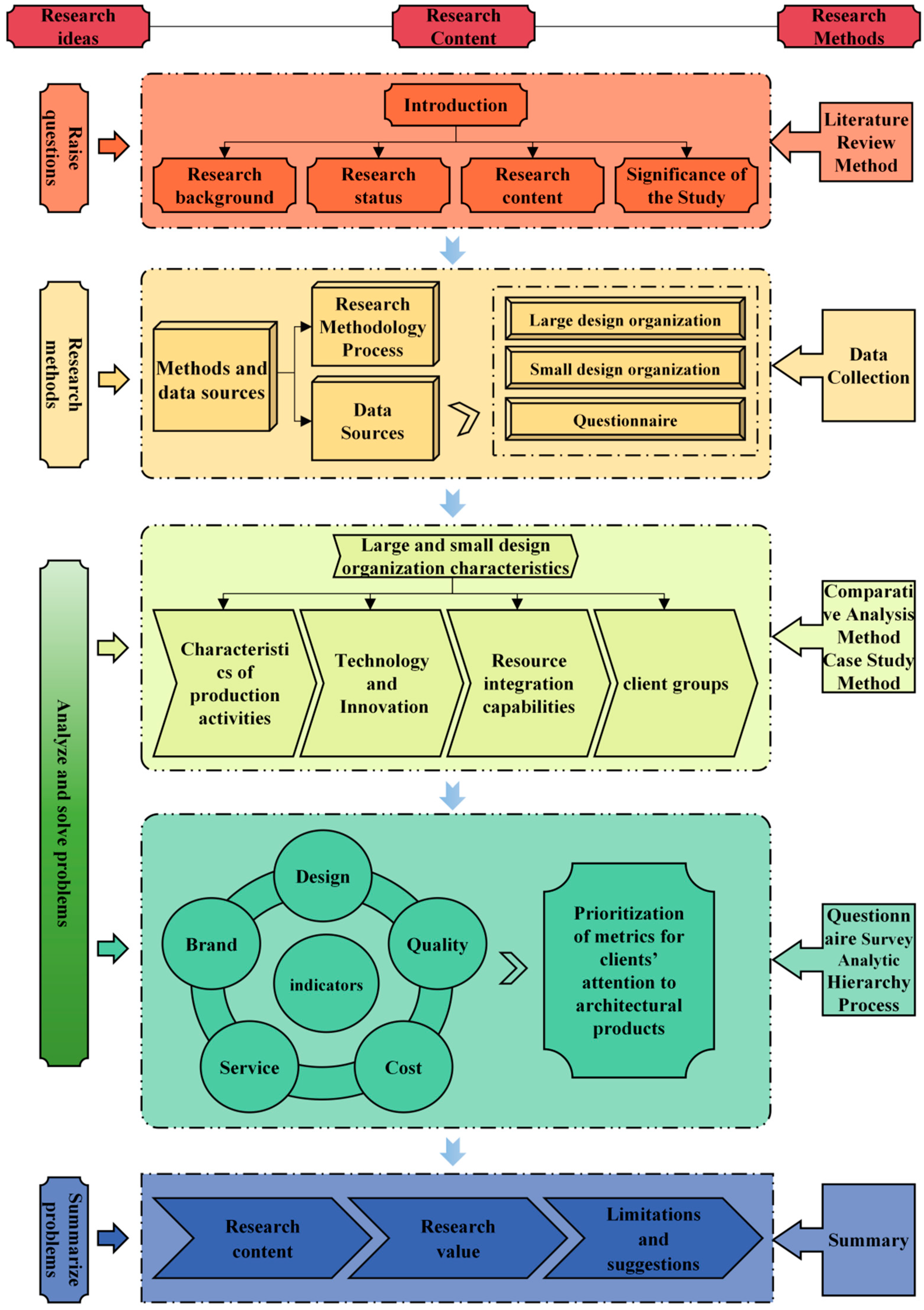
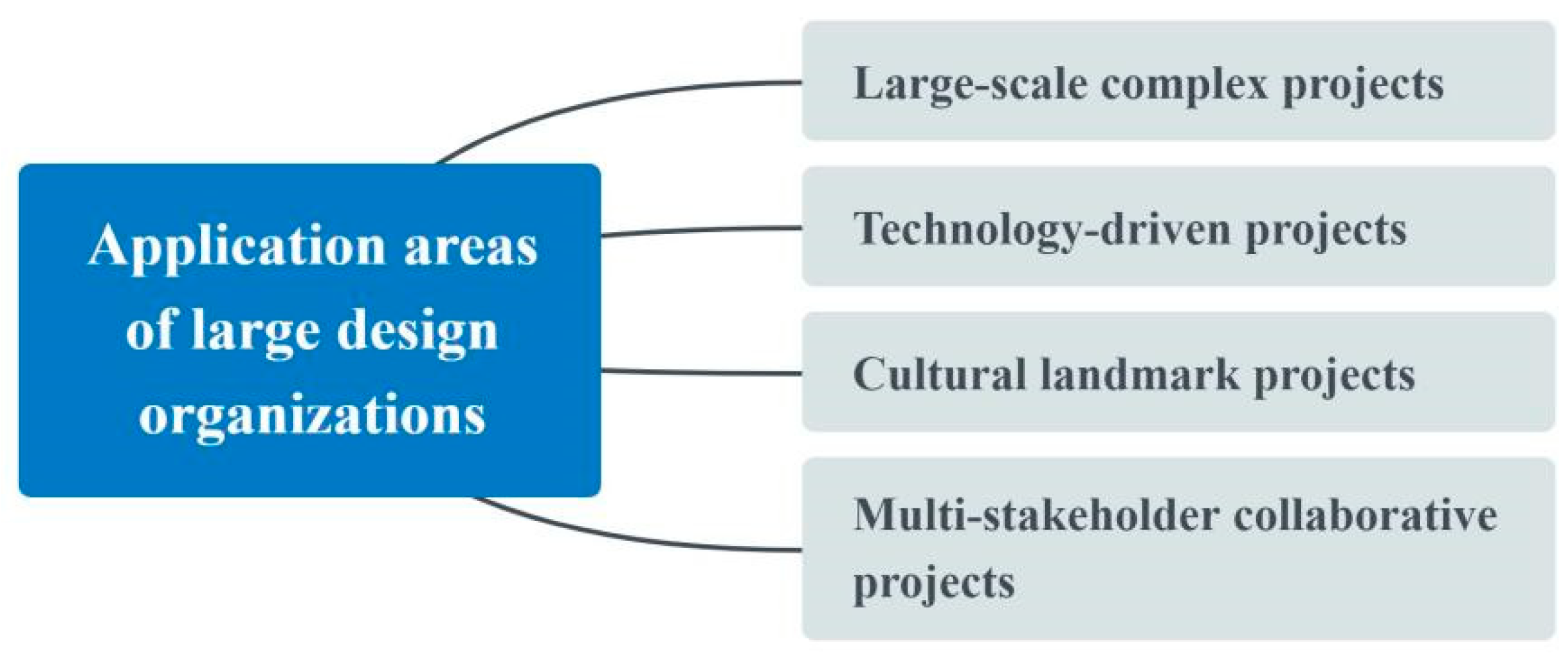


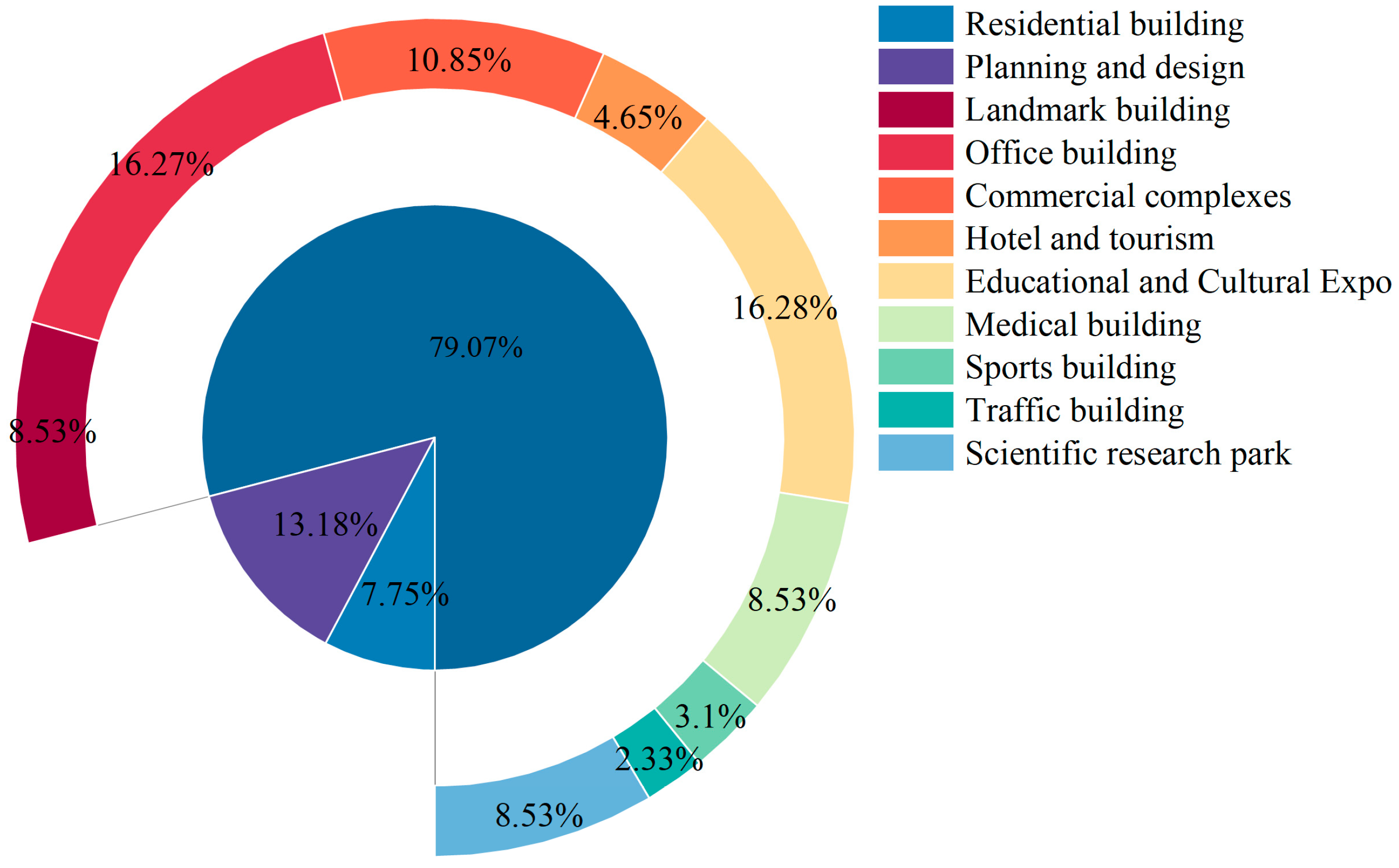
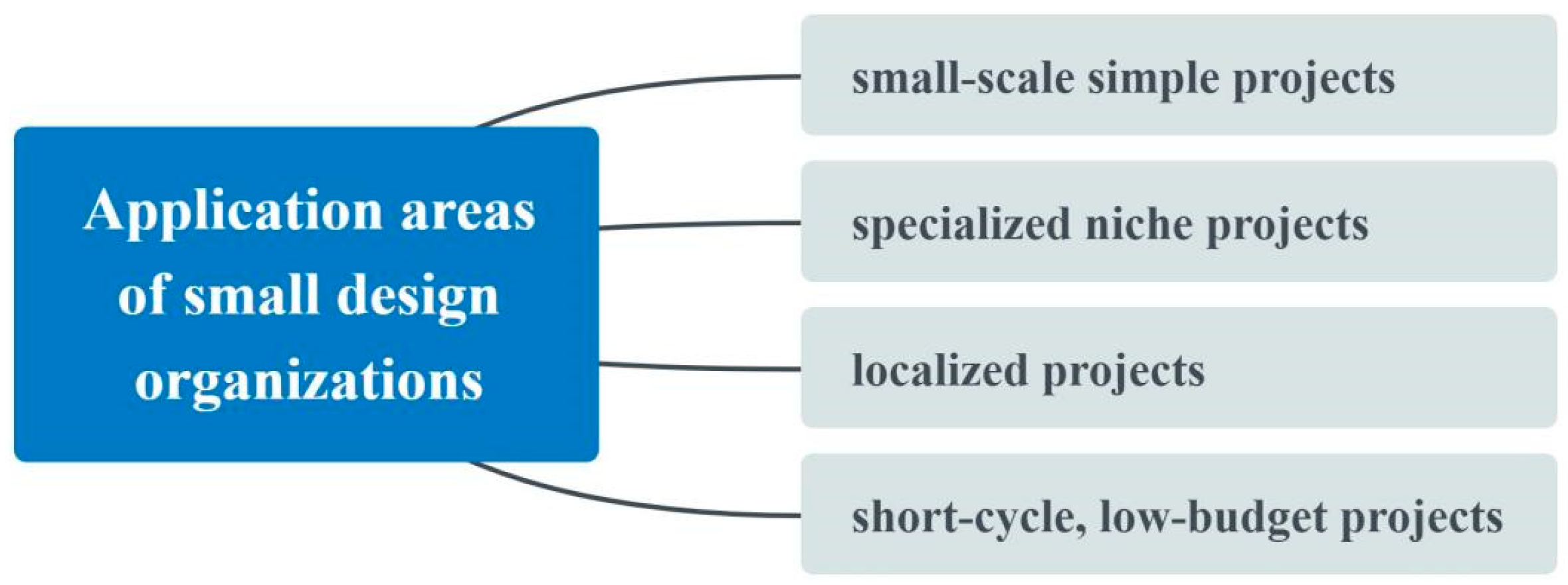
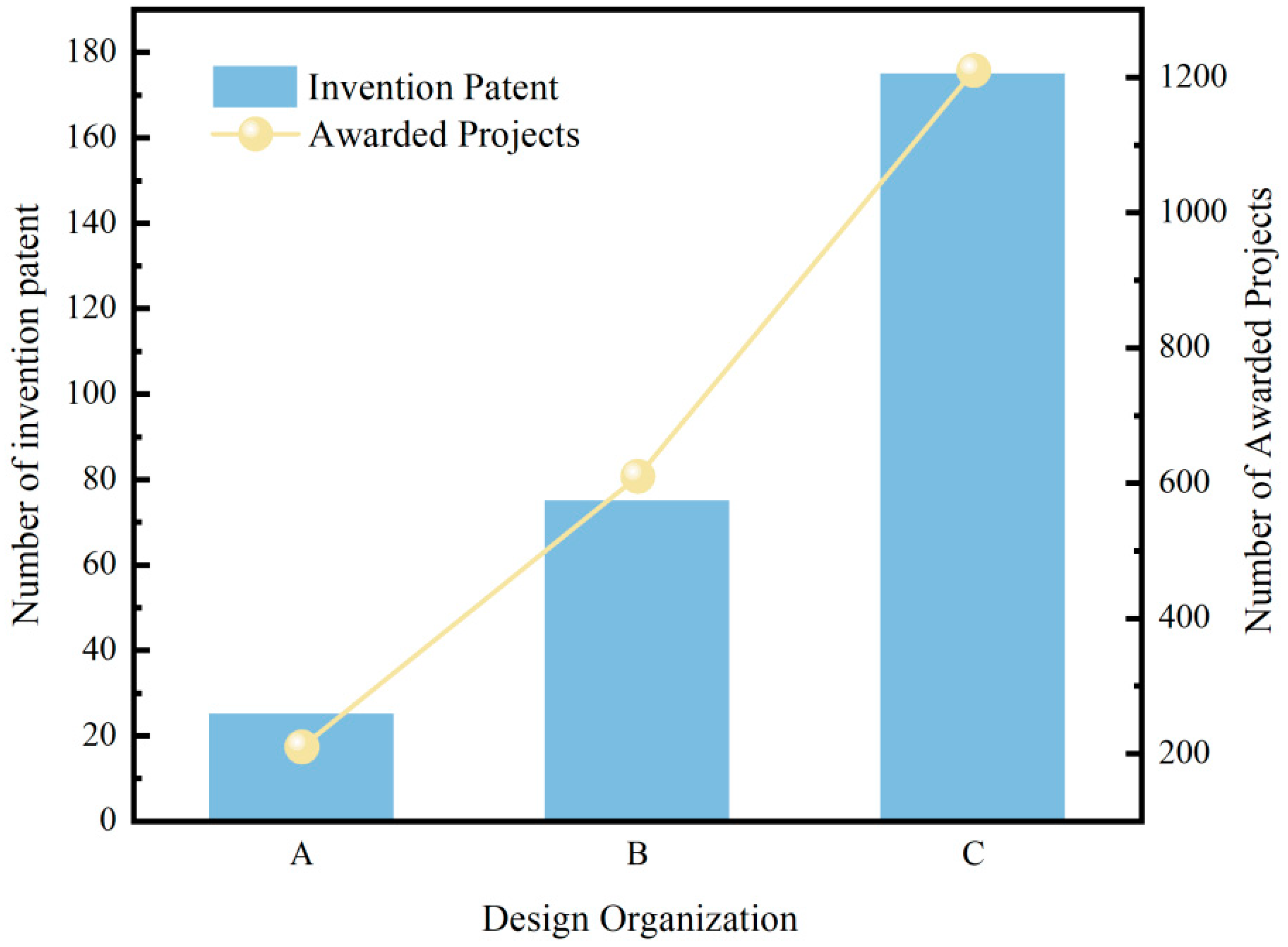
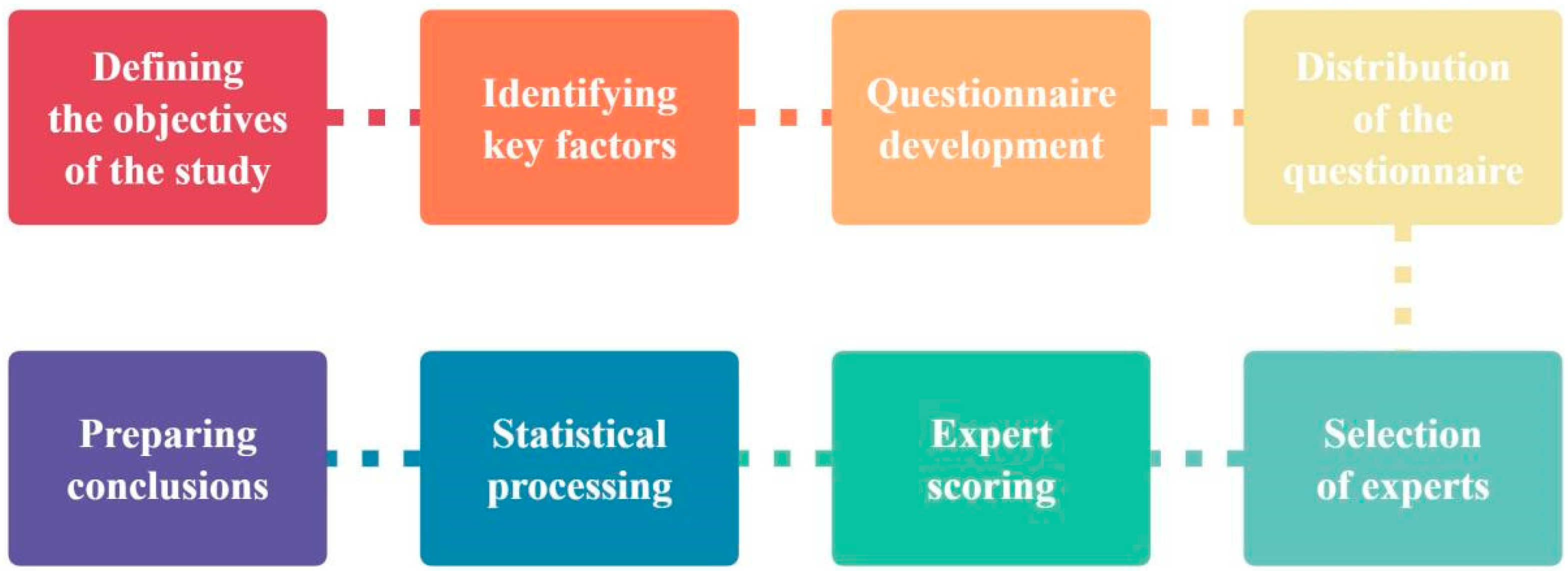
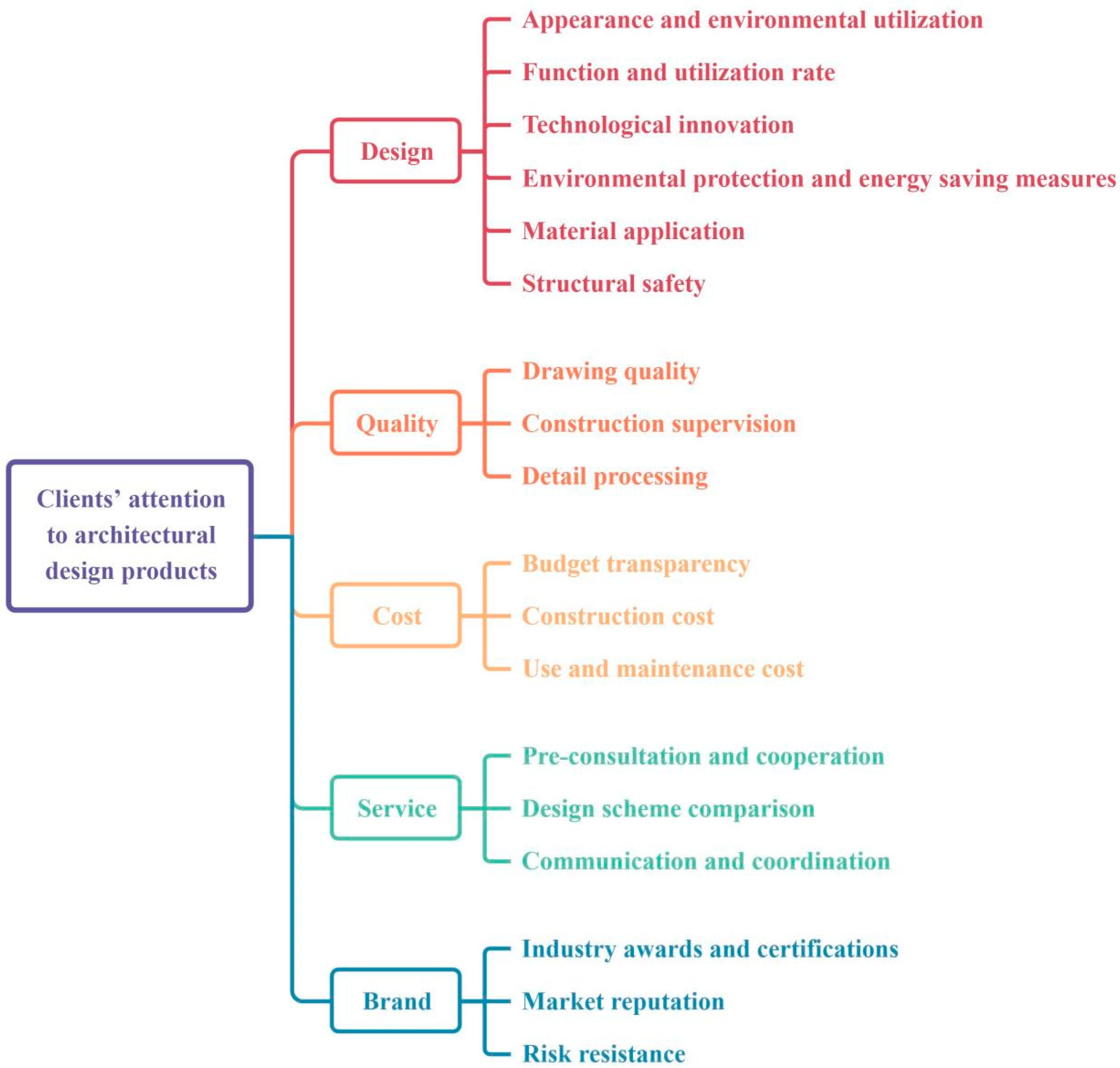
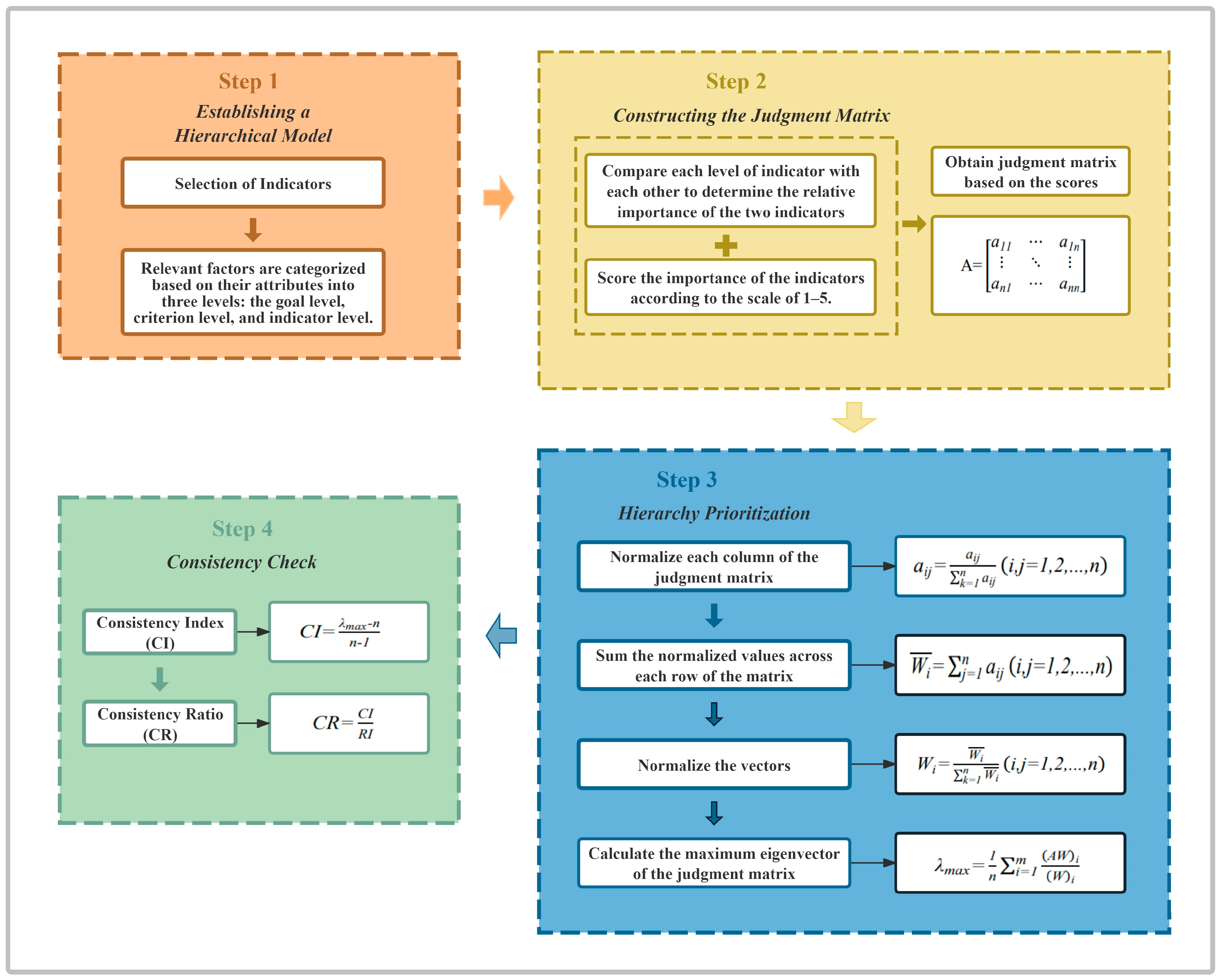
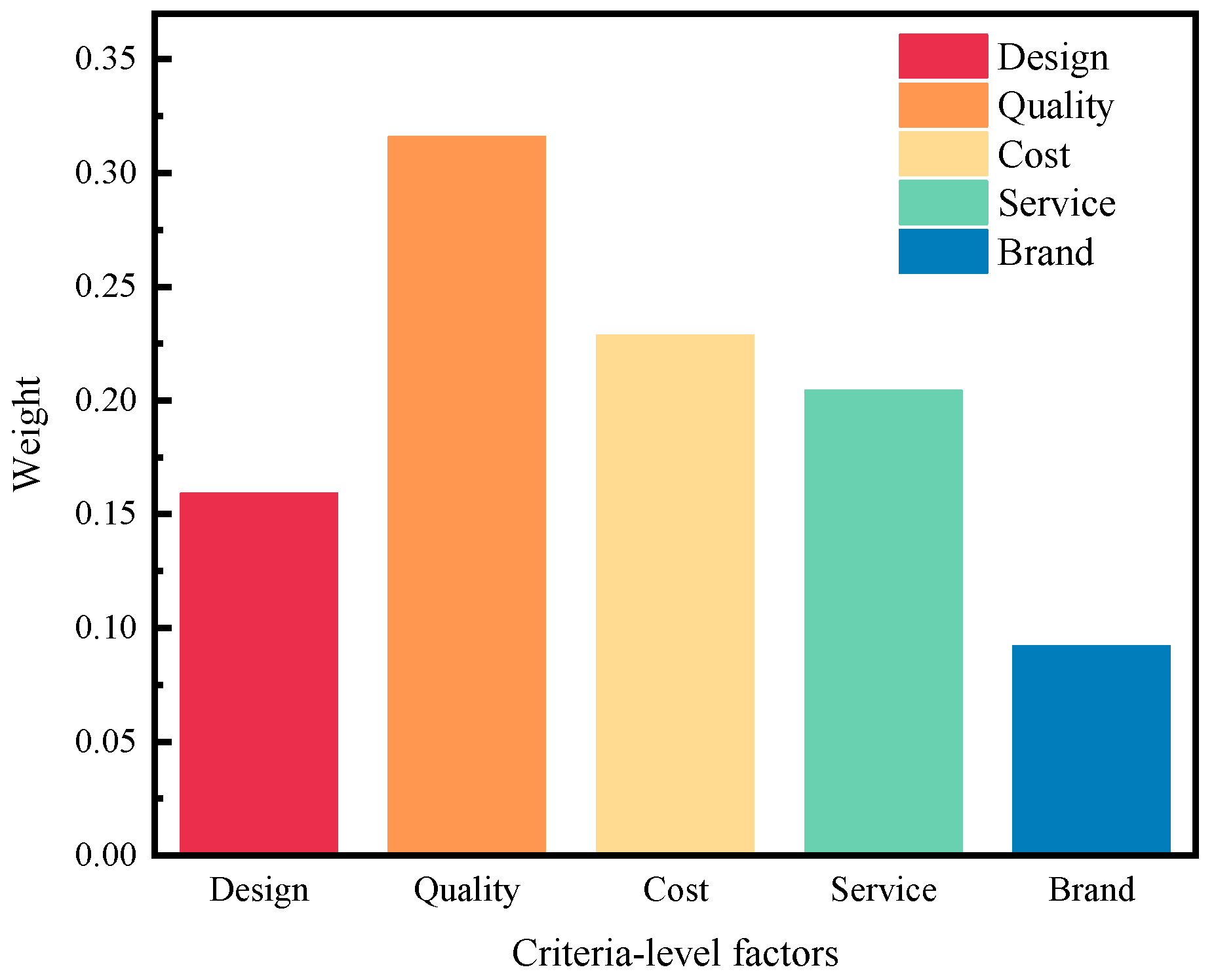

| Industry | Number | Total Number | Data Collection Methods | Data Processing Methods | Questionnaire Collection Period |
|---|---|---|---|---|---|
| Architectural design organizations | 7 | 20 | Questionnaire survey | Excel | 15 days |
| Project owners | 4 | ||||
| Construction organizations | 5 | ||||
| Research institutions | 4 |
| Intensity of Importance | Definition |
|---|---|
| 1 | The two factors are equally important. |
| 2 | The first factor is slightly more important than the second. |
| 3 | The first factor is clearly more important than the second. |
| 4 | The first factor is strongly more important than the second. |
| 5 | The first factor is extremely more important than the second. |
| Reciprocal (1/n) | If factor i is rated relative to factor j, then factor j is 1/n relative to factor i. |
| n | 1 | 2 | 3 | 4 | 5 | 6 | 7 | 8 | 9 |
|---|---|---|---|---|---|---|---|---|---|
| RI | 0.00 | 0.00 | 0.58 | 0.90 | 1.12 | 1.24 | 1.32 | 1.41 | 1.45 |
| Design | Quality | Cost | Service | Brand | |
|---|---|---|---|---|---|
| Design | 1 | 1/2 | 1 | 1/2 | 2 |
| Quality | 2 | 1 | 2 | 2 | 2 |
| Cost | 1 | 1/2 | 1 | 2 | 3 |
| Service | 2 | 1/2 | 1/2 | 1 | 3 |
| Brand | 1/2 | 1/2 | 1/3 | 1/3 | 1 |
| Criterion Level | Criterion Weight | Indicator Level | Indicator Weight | Global Weight |
|---|---|---|---|---|
| Design | 0.1590 | Appearance and environmental utilization | 0.158 | 0.025 |
| Function and utilization rate | 0.178 | 0.028 | ||
| Technological innovation | 0.149 | 0.024 | ||
| Environmental protection and energy-saving measures | 0.151 | 0.024 | ||
| Material application | 0.100 | 0.016 | ||
| Structural safety | 0.265 | 0.042 | ||
| Quality | 0.3159 | Drawing quality | 0.490 | 0.155 |
| Construction supervision | 0.312 | 0.099 | ||
| Detail processing | 0.198 | 0.063 | ||
| Cost | 0.2286 | Budget transparency | 0.187 | 0.043 |
| Construction cost | 0.579 | 0.132 | ||
| Use and maintenance cost | 0.234 | 0.053 | ||
| Service | 0.2044 | Pre-consultation and cooperation | 0.334 | 0.068 |
| Design scheme comparison | 0.142 | 0.029 | ||
| Communication and coordination | 0.525 | 0.107 | ||
| Brand | 0.0921 | Industry awards and certifications | 0.252 | 0.023 |
| Market reputation | 0.159 | 0.015 | ||
| Risk resistance | 0.589 | 0.054 |
Disclaimer/Publisher’s Note: The statements, opinions and data contained in all publications are solely those of the individual author(s) and contributor(s) and not of MDPI and/or the editor(s). MDPI and/or the editor(s) disclaim responsibility for any injury to people or property resulting from any ideas, methods, instructions or products referred to in the content. |
© 2025 by the authors. Licensee MDPI, Basel, Switzerland. This article is an open access article distributed under the terms and conditions of the Creative Commons Attribution (CC BY) license (https://creativecommons.org/licenses/by/4.0/).
Share and Cite
Yang, X.; Fomin, N.I.; Xiao, S.; Liu, C.; Li, J. Analysis of the Characteristics of Production Activities in Chinese Design Organizations. Buildings 2025, 15, 3024. https://doi.org/10.3390/buildings15173024
Yang X, Fomin NI, Xiao S, Liu C, Li J. Analysis of the Characteristics of Production Activities in Chinese Design Organizations. Buildings. 2025; 15(17):3024. https://doi.org/10.3390/buildings15173024
Chicago/Turabian StyleYang, Xu, Nikita Igorevich Fomin, Shuoting Xiao, Chong Liu, and Jiaxin Li. 2025. "Analysis of the Characteristics of Production Activities in Chinese Design Organizations" Buildings 15, no. 17: 3024. https://doi.org/10.3390/buildings15173024
APA StyleYang, X., Fomin, N. I., Xiao, S., Liu, C., & Li, J. (2025). Analysis of the Characteristics of Production Activities in Chinese Design Organizations. Buildings, 15(17), 3024. https://doi.org/10.3390/buildings15173024







